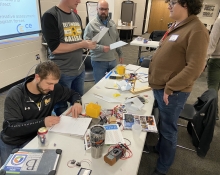Unit Plan: A Community Powered by Renewable Energy
LEARNING GOALS – PART 1
1.Students will define and explain the differences between renewable and non-renewable energy sources.
2.Students will research, summarize, and present the (short- and long-term) benefits and drawbacks of utilizing wind and solar energy.
3.Students will research, summarize, and present the (short- and long-term) benefits and drawbacks of utilizing fossil fuels.
4.Students will generate questions about the greenhouse gas effect, identify and isolate variables, and then conduct an experiment to answer a class generated question about the greenhouse gas effect.
5.Through Socratic seminar, students will use the knowledge gained over the course of this lesson to discuss the potential long- and short-term benefits and drawbacks of using fossil fuels, solar energy, and wind energy.
6.Students will define scientific vocabulary related to electricity.
7.Students will be able to describe how electricity moves through a conductor.
8.Students will draw and describe series and parallel circuits.
9.Students will identify ways that energy is consumed within their homes.
10.Students will perform an energy audit of their home and calculate the amount of energy used by each electronic device and appliances.
11.Students will create a spreadsheet demonstrating the electricity required to operate each electronic device and appliance, along with a summary of finding that clearly identifies how energy consumption can be reduced within their home.
12.Students will explore various ways to reduce energy (goal is 30% reduction).
13.Students will propose a variety of energy reduction plans and present those options to their families for discussion.
14.After discussion with their families, students will itemize the agreed upon plan and identify specific actions that result in quantifiable outcomes that will implemented to reduce energy consumption by their families.
LEARNING GOALS – PART 2
1.Students will gain background information regarding the limitations of having and wind and solar generating infrastructure within city and county limits, including environmental, aesthetic, and cultural considerations.
2.Students will work with professionals to compile criteria for placement of wind and solar energy sources.
3.Students will conduct experiments to collect and analyze data to provide a conclusion to the questions: What is the optimal blade angle for generating the most energy? What is the optimal wind speed for generating the most energy?
4.Students will use prevailing wind data in your region to examine energy output of various sized small wind turbines as wind speeds incrementally increase.
5.Based on local wind speeds, students will determine a range of potential kilowatt generation from wind power.
6.Students will conduct experiments to determine how electrical output of solar panels change as the tilt, azimuth, and shade coverage change.
7.Students will generate, compare, and evaluate various solar configurations for a solar project in your region.
LEARNING GOALS – PART 3
1.Students will utilize previously acquired information about energy needs to create a renewable energy proposal for your town or city.
2.Students will perform a solar audit on their homes and use class averages to project the amount of solar energy that can be generated on residential properties.
3.Students will assess where commercial and municipal solar projects can occur within your town or city to meet the energy needs for non-residential consumers.
4.Students will determine potential locations for larger-scale wind and solar farms to augment the remaining energy needs of the community.
5.Students will prepare a comprehensive renewable energy plan that totals the calculations for potential residential, commercial, and agency renewable energy generation.
6.Students will calculate the average amount of energy generated by wind turbines and solar panels in various conditions to determine the quantity of renewable energy sources required to power the city.
7.Students will use their projected energy calculations to propose a combination of wind and solar sources to meet your locality’s energy needs, based on benefits and drawbacks of each source of energy.
8.Based on prevailing winds and building orientation, students will explore potential sites for wind turbines and solar panels.
9.Students will develop a final proposal to meet future energy needs through a combination of energy generation and reduction of energy consumption, prepare a brief slide presentation that summarizes their comprehensive plans, and present their finding to local energy conservation groups and local government staff or elected officials.
In this three-part comprehensive place-based and project-based unit, students will learn and apply rebnewable energy content to devise action plans at an individual, family, and local level. Students will use primary and secondary research explore energy sources and consumption, ultimately working with local professionals to craft an energy... View full description >>


